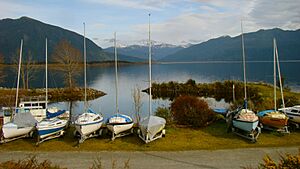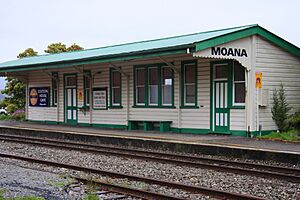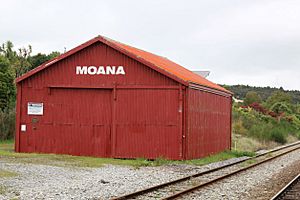Moana, New Zealand facts for kids
Quick facts for kids
Moana
|
|
|---|---|

View of Lake Brunner from Moana
|
|
| Country | New Zealand |
| Region | West Coast |
| District | Grey District |
| Ward | Eastern |
| Electorates |
|
| Area | |
| • Total | 1.16 km2 (0.45 sq mi) |
| Population
(June 2023)
|
|
| • Total | 70 |
| • Density | 60/km2 (156/sq mi) |
| Local iwi | Ngāi Tahu |
Moana is a small town located on the South Island of New Zealand. It's part of the West Coast Region. The town sits right on the northern shore of Lake Brunner. The lake's water flows out near Moana into the Arnold River.
You can cross the Arnold River from Moana using a special suspension bridge just for people walking. On both sides of the river, there are easy walking tracks through the bush.
Moana has a small number of people who live there all the time, usually less than 100. But it's a very popular spot for visitors, especially in the summer. There are about 300 holiday homes and a place for camping.
The best things about Moana for tourists are the amazing views and all the fun water sports you can do on Lake Brunner. The Midland Line railway track goes right through Moana. The famous TranzAlpine tourist train passes by once each day in both directions. Freight trains, mostly carrying coal, also use the tracks often.
In May 2013, Moana was one of the first places in New Zealand to get super-fast 4G wireless internet.
Who Lives in Moana?
Moana is considered a rural settlement by Statistics New Zealand. It covers an area of 1.16 square kilometers. In 2018, about 57 people lived in Moana.
| Historical population for Moana | ||
|---|---|---|
| Year | Pop. | ±% p.a. |
| 2006 | 63 | — |
| 2013 | 66 | +0.67% |
| 2018 | 57 | −2.89% |
Back in 2018, there were 30 homes in Moana. There were slightly more males (33) than females (27). The average age of people living there was 58.4 years. Most residents (89.5%) were of European descent. Some people (10.5%) identified as Māori.
When asked about their beliefs, over half (52.6%) said they had no religion. About 36.8% were Christian.
Moana's School
Lake Brunner School is a school in Moana for students from Year 1 to Year 8. It teaches both boys and girls. As of 2023, it had 106 students. Another school, Rotomanu School, closed in 2005 and joined with Lake Brunner School.
The Railway Story
In 1886, a company called the New Zealand Midland Railway Company agreed to build a railway line. This line would connect Christchurch and Nelson, passing through a place called Brunnerton. The company planned to build and run the railway itself.
By November 1892, the railway line from Brunnerton reached Moana. At first, Moana was just a "flag station," meaning trains would only stop if someone waved a flag. By March 1894, the railway went all the way to Jacksons.
However, the railway company ran into trouble and stopped working in 1895. The New Zealand Government then took over the railway project. They finished building the line themselves.
The arrival of the railway helped more people settle in Moana. It also led to the creation of timber mills in the area. By June 1895, a sawmill company was already using a 140-meter-long railway siding at Moana station. The original Moana railway station building had a 61-meter-long platform and a 240-meter siding by 1895.
Sadly, on April 16, 1926, the station building was destroyed in a fire. A new building was built in the same year. This new station was designed by a famous railway architect named George Troup.
Today, the Moana Railway Station is very important. Heritage New Zealand has listed it as a Category 1 Historic Place. This means it's a place of great historical value. It's the only station of its kind that still has its original sidings (extra tracks) and goods sheds (buildings for storing goods). The entire Moana Railway Station Historic Area, which includes the station building, a footbridge, the goods shed, and the old station master's house (now a cafe), is also a Category 1 Historic Place.



